高三英语语法知识--英语知识体系简介
高中英语语法体系结构要点

高中英语语法体系结构要点高一部分:句子成分(全部,含认知与应用)、时态(全部,含认知与应用)定语从句、名词性从句、状语从句、非谓语动词、并列句(基本概念、结构与解题思路)句子成分:基本概念–主语、谓语、宾语、定语、状语、补语、表语和同位语。
基本结构–单句中句子成分的划分注意事项–以传统语法为准难点:状语、定语与宾补的区分时态:基本概念–现在时(一般、进行、完成、完成进行)、过去时(一般、进行、完成、完成进行)、将来时(一般、进行、完成)基本结构–各类时态间的差别难点:时态一致定语从句:基本概念–先行词、引导词、关系代词、关系副词、限制性定从、非限制性定从基本结构–that /which 差别、whose/of whichas 基本用法、介词+which 基本用法引导词的省略注意事项–定语从句必有先行词名词性从句:基本概念–主语从句、宾语从句、表语从句、同位语从句基本结构–who/whoever、what/which、that 、it (主从)宾语类型(宾从)系表结构(表从)同位语与同位语从句(同从)注意事项–部分引导词与定从中的差异状语从句:基本概念–时间、地点、原因、方式、让步、比较等状语基本结构–各类状从的引导词主要状从的使用注意事项–以初中所学的复习为主,不做深入讲解并列句:基本概念–连词(and/but/yet/so/for/or)基本结构–连词所并列的两个单句,区分主从与并列注意事项–认知即可非谓语动词:基本概念–不定式、分词(动名词、现在分词、过去分词)基本结构–非谓语用作定语、状语、宾补的基本用法非谓语动词的时间和语态的差别注意事项–认知为主,课文内知识和详细讲解●从句类基本解题思路:谓语个数–几句话–有无连词–确定主从或并列关系主句所缺成分–确定从句类型从句所缺成分–确定引导词难点:先确定从句类型,后选择引导词●非谓语基本解题思路:谓语个数–确定是否使用非谓语时间先后与主被动–确定使用何种非谓语难点:规则繁多,本阶段以掌握基本概念为主,课文中已有的可适当补充高二部分:三大从句、非谓语动词(具体要求及难题解析)倒装、虚拟、比较结构(基本概念、结构与解题思路)三大从句:具体要求–三种考点、补充引导词but\than(定从)that (定从名从差别)that省略(表从、宾从)that 成分替代(同从与定从)状从使用(略)难题解析–高考例题的解析非谓语动词:具体要求–非谓语在句子各个成分位置上的使用to 的省略主动表被动的类别和使用独立结构的不定式与分词难题解析–高考例题的解析倒装:基本概念–完全倒装、部分倒装、标志基本结构–完全倒装(3种)部分到装(全部)注意事项–倒装在翻译中的使用基本思路–注意标志,分清类别虚拟:基本概念–虚拟语气基本结构– if 条件句、wish、建议、命令注意事项–不接触过难的虚拟类别基本思路–注意虚假,分清类别比较结构:基本概念–比较基本结构– more than、as…as 、the … ofmore … than …(no more … than… )the more … the more ….注意事项–比较结构的对称性和完整性基本思路–对称高三部分:倒装、虚拟、比较结构(具体规则与难题解析)主谓一致、连词、代词、冠词、介词、形容词、反意疑问、强调(全部,含认知与应用)倒装:具体要求–掌握完全倒装和部分倒装的所有规则。
高三英语语法知识点归纳总结

高三英语语法知识点归纳总结一、主语一致性主语一致性是指主语与谓语在人称(第一人称、第二人称和第三人称)、单复数以及人称代词的一致关系。
例如:1. She is my best friend.(主语和谓语都是第三人称单数)2. We are going to the beach tomorrow.(主语和谓语都是第一人称复数)3. You should take care of yourselves.(主语和谓语都是第二人称复数)二、时态时态是英语中表示动作或状态发生时间的形式。
常用的时态有一般现在时、一般过去时、一般将来时和现在进行时等。
例如:1. I go to school every day.(一般现在时)2. She studied English last night.(一般过去时)3. They will visit their grandparents next week.(一般将来时)4. He is watching a movie now.(现在进行时)三、动词的用法动词的用法包括动词的时态、语态和不定式等。
常见的动词用法有:1. 不及物动词:动词本身可以独立构成句子,不需要宾语。
例如:She runs in the park every morning.(run为不及物动词)2. 及物动词:动词后面需要接宾语才能构成完整句子。
例如:He drinks coffee every day.(drink为及物动词)3. 动词的时态变化:动词根据时间的不同,需要进行时态的变化。
例如:I will go to the party tomorrow.(go的一般现在时是"go",一般将来时是"will go")4. 动词的语态变化:包括主动语态和被动语态。
例如:She writes a letter.(主动语态)A letter is written by her.(被动语态)四、从句从句是指在一个句子中,可以独立存在但是不能单独构成句子的句子。
英语高考必考语法知识点归纳
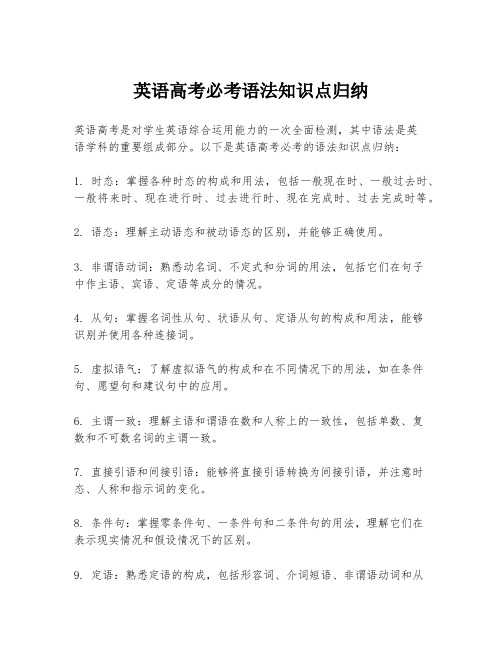
英语高考必考语法知识点归纳英语高考是对学生英语综合运用能力的一次全面检测,其中语法是英语学科的重要组成部分。
以下是英语高考必考的语法知识点归纳:1. 时态:掌握各种时态的构成和用法,包括一般现在时、一般过去时、一般将来时、现在进行时、过去进行时、现在完成时、过去完成时等。
2. 语态:理解主动语态和被动语态的区别,并能够正确使用。
3. 非谓语动词:熟悉动名词、不定式和分词的用法,包括它们在句子中作主语、宾语、定语等成分的情况。
4. 从句:掌握名词性从句、状语从句、定语从句的构成和用法,能够识别并使用各种连接词。
5. 虚拟语气:了解虚拟语气的构成和在不同情况下的用法,如在条件句、愿望句和建议句中的应用。
6. 主谓一致:理解主语和谓语在数和人称上的一致性,包括单数、复数和不可数名词的主谓一致。
7. 直接引语和间接引语:能够将直接引语转换为间接引语,并注意时态、人称和指示词的变化。
8. 条件句:掌握零条件句、一条件句和二条件句的用法,理解它们在表示现实情况和假设情况下的区别。
9. 定语:熟悉定语的构成,包括形容词、介词短语、非谓语动词和从句等,以及它们在句子中的位置。
10. 介词:掌握常用介词的用法,包括时间、地点、方式等,并注意介词短语在句子中的作用。
11. 冠词:理解不定冠词、定冠词和零冠词的使用规则。
12. 疑问句:能够构造各种类型的疑问句,包括一般疑问句、特殊疑问句和选择疑问句。
13. 强调句:掌握强调句的构成和用法,能够通过强调句型来突出句子中的某个部分。
14. 倒装句:理解倒装句的构成和使用场合,包括部分倒装和完全倒装。
15. 省略句:了解省略句的构成和使用条件,能够在适当的情况下使用省略。
掌握这些语法点不仅有助于提高英语写作和阅读理解能力,也是英语高考取得高分的关键。
建议学生通过大量的练习和实际应用来巩固这些知识点。
高三英语语法知识点

高三英语语法知识点对于高三的学生来说,英语语法是英语学习中至关重要的一部分。
掌握好语法知识,不仅能够在考试中取得好成绩,还能为日后的英语交流和应用打下坚实的基础。
以下是一些高三英语语法的重要知识点。
一、动词时态和语态动词的时态和语态是语法中的重点和难点。
常见的时态有一般现在时、一般过去时、一般将来时、现在进行时、过去进行时、现在完成时、过去完成时等。
一般现在时表示经常发生的动作或存在的状态,例如:“I go to school every day”(我每天去上学。
)一般过去时用于描述过去发生的动作,比如:“He played basketball yesterday”(他昨天打篮球了。
)一般将来时表示将来要发生的动作,常见的表达有“will +动词原形”和“be going to +动词原形”,像:“I will visit my grandparents next week”(我下周将去看望我的祖父母。
)现在进行时表示正在进行的动作,结构是“be +现在分词”,例如:“She is reading a book now”(她现在正在读书。
)过去进行时强调过去某个时刻正在进行的动作,例如:“When I called him, he was having dinner”(当我给他打电话时,他正在吃晚饭。
)现在完成时表示过去发生的动作对现在造成的影响或结果,或者从过去开始一直持续到现在的动作,常用“have/has +过去分词”,比如:“I have lived here for five years”(我在这里住了五年了。
)过去完成时则是过去的过去发生的动作,结构为“had +过去分词”,例如:“By the time I got there, the train had already left”(当我到那儿时,火车已经开走了。
)语态分为主动语态和被动语态。
被动语态的构成是“be +过去分词”,例如:“The book was written by him”(这本书是他写的。
英语知识体系简介

语法知识英语知识体系简介十大词类:noun, pronoun, adjective, adverb, numeral, verb, article, preposition, conjunction, Interjection九种句子成分主语(subject): 是句子所要说明的人或事物,是句子的主体。
(n., pron.,to do, doing and that-clause)谓语(predicate): 说明主语所发出的动作或从的状态。
(verbs)表语(predicative): 放在连系动词之后,表示主语的身分、状态或特征。
(n., pron., adj., adverbs for places, prepositional phrases, to do doing, done and that-clause.)宾语(object): 在及物动词或介词之后。
(n, pron, to do, doing and that-clause.)定语(attribute): 限定或修饰名词或代词。
adj., adverbs for places, pron, n., prepositional phrases, to do, doing, done and that-clauses.状语(adverbial) : 修饰动词、形容词、副词或整个句子。
adv., prepositional phrases, to do, doing done and that-clauses.宾语补足语(object complement): 说明宾语的性质、状态、特征或宾语发出的动作。
(adj., n, adverbs for places, to do, doing and done)同位语: 补充说明前面的某个名词或代词。
(n. or that-clauses)e.g. My father, a doctor, is very kind.主语补足语: 是对一句话的主语进行补充说明。
高三英语 英语语法基础知识:形容词、副词、介词、连词 知识精讲
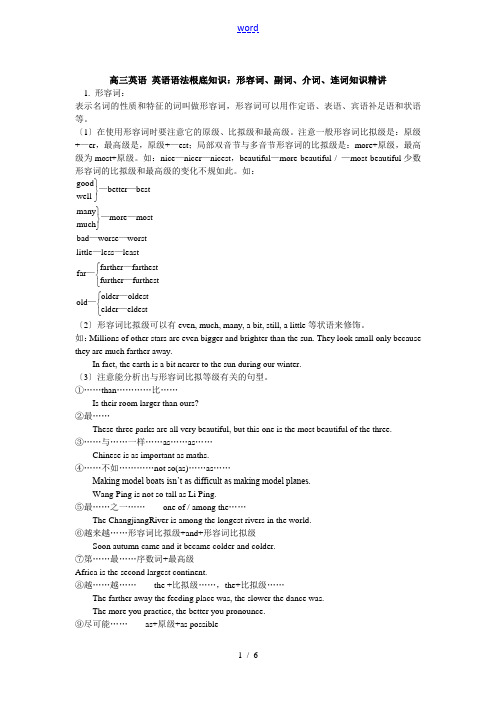
高三英语英语语法根底知识:形容词、副词、介词、连词知识精讲1. 形容词:表示名词的性质和特征的词叫做形容词,形容词可以用作定语、表语、宾语补足语和状语等。
〔1〕在使用形容词时要注意它的原级、比拟级和最高级。
注意一般形容词比拟级是:原级+—er,最高级是,原级+—est;局部双音节与多音节形容词的比拟级是:more+原级,最高级为most+原级。
如:nice—nicer—nicest,beautiful—more beautiful / —most beautiful少数形容词的比拟级和最高级的变化不规如此。
如:goodwellbetter bestmanymuchmore mostbad worse worstlittle less leastfar farther farthest further furthestoldolder oldestelder eldest ⎫⎬⎭⎫⎬⎭⎧⎨⎩⎧⎨⎩——————————————〔2〕形容词比拟级可以有even, much, many, a bit, still, a little等状语来修饰。
如:Millions of other stars are even bigger and brighter than the sun. They look small only because they are much farther away.In fact, the earth is a bit nearer to the sun during our winter.〔3〕注意能分析出与形容词比拟等级有关的句型。
①……than…………比……Is their room larger than ours?②最……These three parks are all very beautiful, but this one is the most beautiful of the three. ③……与……一样……as……as……Chinese is as important as maths.④……不如…………not so(as)……as……Making model boats isn’t as difficult as making model planes.Wang Ping is not so tall as Li Ping.⑤最……之一……one of / among the……The ChangjiangRiver is among the longest rivers in the world.⑥越来越……形容词比拟级+and+形容词比拟级Soon autumn came and it became colder and colder.⑦第……最……序数词+最高级Africa is the second largest continent.⑧越……越……the +比拟级……,the+比拟级……The farther away the feeding place was, the slower the dance was.The more you practice, the better you pronounce.⑨尽可能……as+原级+as possibleThe old men and the boys made the wounded as comfortable as possible.〔4〕如下词一般只用作表语,不用作定语。
高中英语语法系统全解
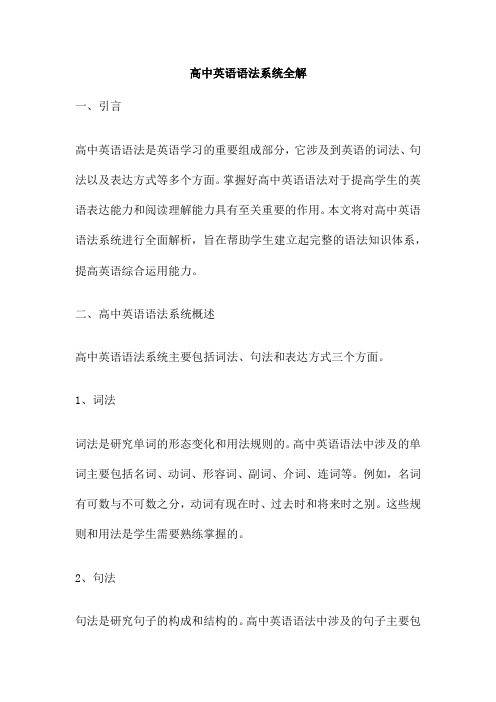
高中英语语法系统全解一、引言高中英语语法是英语学习的重要组成部分,它涉及到英语的词法、句法以及表达方式等多个方面。
掌握好高中英语语法对于提高学生的英语表达能力和阅读理解能力具有至关重要的作用。
本文将对高中英语语法系统进行全面解析,旨在帮助学生建立起完整的语法知识体系,提高英语综合运用能力。
二、高中英语语法系统概述高中英语语法系统主要包括词法、句法和表达方式三个方面。
1、词法词法是研究单词的形态变化和用法规则的。
高中英语语法中涉及的单词主要包括名词、动词、形容词、副词、介词、连词等。
例如,名词有可数与不可数之分,动词有现在时、过去时和将来时之别。
这些规则和用法是学生需要熟练掌握的。
2、句法句法是研究句子的构成和结构的。
高中英语语法中涉及的句子主要包括简单句、并列句和复合句。
简单句由一个主语和一个谓语构成,并列句由两个或两个以上的简单句组成,复合句则由主句和从句组成。
英语的时态、语态和语气也是句法的重要组成部分。
3、表达方式表达方式是研究如何运用单词和句子进行有效表达的。
高中英语语法中涉及的表达方式主要包括陈述句、疑问句、祈使句和感叹句。
陈述句用于陈述事实,疑问句用于提出问题,祈使句用于发出命令或请求,感叹句用于表达强烈的情感。
修辞手法如比喻、拟人、排比等也是表达方式的一部分。
三、高中英语语法重点难点解析1、动词时态和语态动词时态和语态是高中英语语法中的重点和难点之一。
学生需要熟练掌握各种时态的构成和用法,如一般现在时、现在进行时、过去完成时等。
同时,还要理解语态的概念和用法,如主动语态和被动语态。
2、名词和冠词名词和冠词是高中英语语法中的基础内容之一。
学生需要了解名词的分类和复数形式,掌握冠词的用法和区别,如不定冠词和定冠词。
3、状语从句和名词性从句状语从句和名词性从句是高中英语语法中的重要句型之一。
学生需要掌握状语从句的用法和类型,如时间状语从句、条件状语从句等。
同时,还要理解名词性从句的概念和用法,如主语从句、表语从句等。
高三英语高考语法知识点归纳总结形容词和副词

用比较级来表达最高级的意思
我从来没有度过这样令人烦恼的一天。 (意为:我度过了最为令人烦恼的一天。 )
表达法一: A is three(four, etc.)times the size(height,
length etc.)of B. The new building is four times the size(the height)of the old one. 这座新楼是那座旧楼的四倍大(高) / 这座新楼比那 座旧楼大(高)三倍。 表达法二: A is three(four, etc.)times as big(high, long,
perfect, superior,junior 等
twice 或 double. 注意: 1. 可以修饰比较级的词有: much, many, a lot, even, far, a bit, a little, still, yet, by far, any,
a great deal;
2. 表示“最高程度“的形容词没有最高级和比较级。如:
favourite, excellent, extreme,
only 修饰的名词之后
the best book available, the only solution possible
alive, alike, awake, aware, asleep 等作定语时后 3
置
the only person awake
4 和空间、时间、单位连用时 5 成对的形容词可以后置
a bridge 50 meters long a huge room simple and beautiful
6 形容词短语一般后置
a man difficult to get on with
高中英语语法知识体系

形容词、副词易错点 比较等级
(重点2)
比较级、最高级的构成 原级的用法 比较级的用法 最高级的用法 比较等级的修饰语
(每册)
(必修1、必修2)
词义辨析(重点1)
六、代词和数词
代词
人称代词 物主代词 反身代词 指示代词 疑问代词 相互代词 关系代词 连接代词 (重点1) 不定代词 替代词(重点2) (重点3) (必修2、选修6) It的用法
高中英语语法 知识体系
名词和冠词 系动词 形容词和副词 非谓语动词 助动词 动词 实义动词 代词和数词 情态动词 介词和连词 合成法 动词的时态 动词的语态
词类
(每册) 词法
构词法
(必修4)
转化法 派生法 缩略法
句子成分
主语、谓语、宾语、表语
定语、状语、补足语、同位语 简单句
主谓一致 虚拟语气
句子结构
名词所有格
of所有格 双重所有格
名词的句法功能
主语、宾语、表语、同位语 定语、状语、补足语(重点)
不定冠词 a/an
(重点1)
①首次提到的人或物
②泛指一类人或事物
④抽象名词具体化
③表示微弱的“一”的概念
二、冠词①特指上文提到的人或物
定冠词 the
(重点2)
⑤用在序数词前,表示“又一,再一” ②特指双方都明确的人或物
基数词
数词
序数词 数词的应用
(选修8)
时间介词 地点、方位介词
七、介词和连词 介词
介词的宾语
其他介词(重点4)
介词短语的句法功能 介词的固定搭配 (重点2) (每册)
从属连词 (重点1)
连词
(必修2)
并列连词 (重点3)
江苏高三英语语法知识点
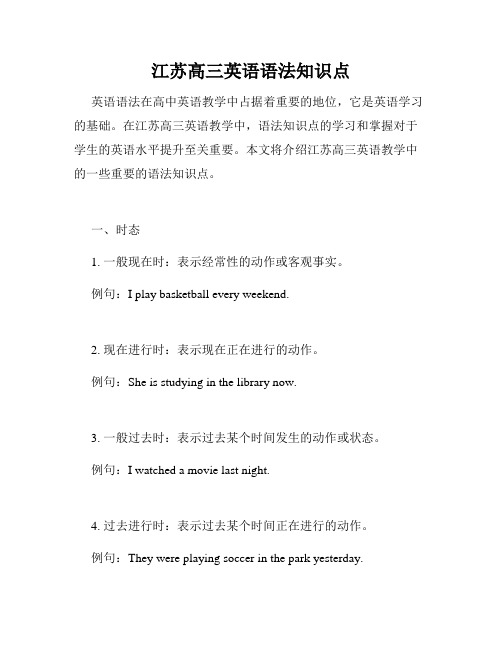
江苏高三英语语法知识点英语语法在高中英语教学中占据着重要的地位,它是英语学习的基础。
在江苏高三英语教学中,语法知识点的学习和掌握对于学生的英语水平提升至关重要。
本文将介绍江苏高三英语教学中的一些重要的语法知识点。
一、时态1. 一般现在时:表示经常性的动作或客观事实。
例句:I play basketball every weekend.2. 现在进行时:表示现在正在进行的动作。
例句:She is studying in the library now.3. 一般过去时:表示过去某个时间发生的动作或状态。
例句:I watched a movie last night.4. 过去进行时:表示过去某个时间正在进行的动作。
例句:They were playing soccer in the park yesterday.5. 一般将来时:表示将来某个时间会发生的动作。
例句:We will go shopping this weekend.二、语态1. 被动语态:将主动语态的动词改为被动语态时,需改变动词的形式。
例句:The book was written by him.2. 主动语态:表示主语是动作的执行者。
例句:She writes a letter.三、句型1. 定语从句:用来修饰一个名词或代词的句子。
例句:The book that I borrowed from the library is very interesting.2. 状语从句:用来表示时间、条件、原因、目的等情况的从句。
例句:He went to bed early because he was tired.3. 宾语从句:用来作及物动词或介词后的宾语的从句。
例句:I believe that she can do it.四、虚拟语气1. 虚拟条件句:表示与现在或将来事实相反的情况。
例句:If I were you, I would study harder.2. 虚拟假设句:表示与过去事实相反的情况。
构词法-备战2023年高考英语复习语法知识点全面梳理(全国通用)

副词+现在分词 hard-working, far-seeing, well-meaning
副词+过去分词 well-prepared, quickly-cured, well-known
3.3 合成法
复合名词的构成
方式
例词
名词+名词 形容词+名词 动名词+名词 动词+副词 动词+名词
horseback , bank-note, newspaper, cell-phone back-yard, forehead, greenhouse, blackboard hiding-place, reading-room get-off, break-in, breakdown, breakup pickpocket , break-water
词类 数词 副词
后缀 -teen -ty -th -ly
例词 thirteen 十三 fifteen 十五 twenty 二十 fifth 第五 carefully 细心地 happily 开心地
3.2 转化法
3.3 合成法
复合形容词的构成
方式
例词
形容词+名词
first-class, part-time, second-hand, bare-foot
常用后缀 词类
形容词
后缀
-able, -ible
-al -ed -en -ern
-ing
例词
comfortable舒服的 enjoyable 快乐的 flexible灵活的
traditional 传统的 national 民族的 surprised 感到吃惊的 wooden 木制的 golden 金的 eastern 东方的 western 西方的
高中的英语语法知识体系

高中的英语语法知识体系高中英语语法知识一、非谓语动词“非谓语动词”可分为动词不定式、动名词和分词。
它在句子中的作用很多:除了不作谓语外,它可以充当主语、宾语、表语、定语、状语与复合宾语(主语补语或宾语补语)。
有些及物动词后面接不带to的不定式作复合宾语。
这些动词归纳如下:一感(feel).二听(hear,listen to),三让(have,1et, make),四看(see,watCh,notice,observe)。
再加上help somebody(to)do something和美国英语look at somebody do somthing。
还有“二让”属特殊:get somebody to do something 与keep somebody doing。
而有些及物动词后面接动名词(the -ing form)作宾语。
这些动词归纳为一句话:Papa C makes friends。
这是由如下动词的开头字母组成:permit,advise, practise,avoid,consider,mind,allow,keep,enjoy,suggest, finish,risk,imagine,escape,need,delay,stand(忍受)。
为了容易记住,也可以编成顺口溜:“允许完成练习,建议避免冒险,考虑延期逃跑,喜欢保持想象,需要反对忍受”。
其相对应的动词依次是:permit/allow,finish,practise;advise/suggest, avoid,risk: consider, delay, escape/miss; enjoy/appreciate, keep, imagine; need/want/require,mind. can'thelp/can’t stand。
二、复合句1、学生最容易混淆的是定语从句与同位语从句的区别。
例如:A、The news that our team has won the match is true. (同位语从句)B、The news that he told us surprised everybody here. (定语从句)关键的区别在于连接或关系代词that:有意义的是定语,无意义的是同位。
英语语法新思维--语法体系及底层逻辑全解密
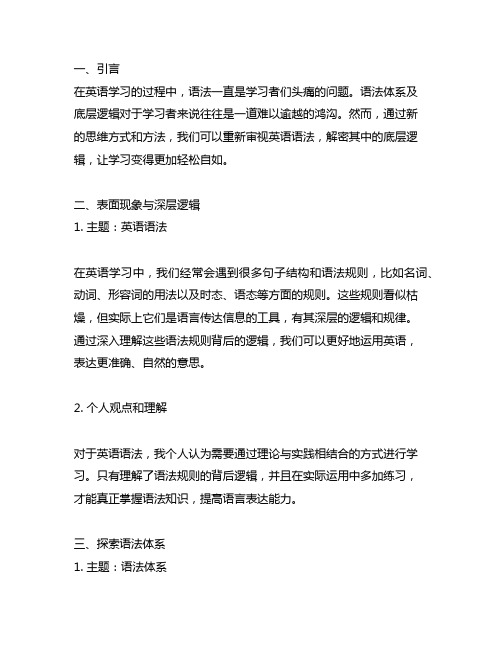
一、引言在英语学习的过程中,语法一直是学习者们头痛的问题。
语法体系及底层逻辑对于学习者来说往往是一道难以逾越的鸿沟。
然而,通过新的思维方式和方法,我们可以重新审视英语语法,解密其中的底层逻辑,让学习变得更加轻松自如。
二、表面现象与深层逻辑1. 主题:英语语法在英语学习中,我们经常会遇到很多句子结构和语法规则,比如名词、动词、形容词的用法以及时态、语态等方面的规则。
这些规则看似枯燥,但实际上它们是语言传达信息的工具,有其深层的逻辑和规律。
通过深入理解这些语法规则背后的逻辑,我们可以更好地运用英语,表达更准确、自然的意思。
2. 个人观点和理解对于英语语法,我个人认为需要通过理论与实践相结合的方式进行学习。
只有理解了语法规则的背后逻辑,并且在实际运用中多加练习,才能真正掌握语法知识,提高语言表达能力。
三、探索语法体系1. 主题:语法体系英语语法体系是一门复杂的学科,涉及到词汇、句法、语法、音韵等多个方面的知识。
通过深入探索语法体系的底层逻辑,我们可以更好地理解语言结构和语法规则。
2. 个人观点和理解在学习语法体系时,我发现采用分类整理的方法可以帮助我们更好地理解和记忆知识点。
将名词、动词、形容词等按照其用法和特点进行分类,可以帮助我们更有条理地学习和掌握语法知识。
四、解密底层逻辑1. 主题:底层逻辑语法规则背后隐藏着严密的逻辑和规律。
通过解密底层逻辑,我们可以更好地理解语法规则的运用和变化,从而提高语言表达的准确性和流利度。
2. 个人观点和理解在解密底层逻辑时,我发现需要以逻辑思维和分析能力为基础。
通过分析句子结构和语法规则的变化,我们可以逐步理解其背后的逻辑和规律,从而更灵活地应用于实际语言交流中。
五、总结与回顾通过本文的探讨,我们重新审视了英语语法的学习方式和方法。
深入探索语法体系和解密底层逻辑,可以帮助我们更好地理解和应用语法知识,提高语言表达能力。
希望大家可以从新的思维方式和方法出发,重新学习英语语法,让学习变得更加轻松自如。
高中英语语法总结大全 英语语法基础知识整理

高中英语语法总结大全英语语法基础知识整理英语语法是针对英语语言进行研究后,系统地总结归纳出来的一系列语言规则。
英语语法的精髓在于掌握语言的使用。
1高中英语语法大全一、主语从句1.定义:用作主语的从句叫做主语从句。
2.构成:关联词+简单句3.引导主语从句的关联词有三类:(1)从属连词that。
如:Thattheywereintruthsisterswasclearfromthefacialresemblancebetweenthem.很明显,她们确是亲姐妹,她们的脸型很相似。
(2)从属连词whether。
如:Whetherhe’llcomehereisn’tclear.他是否会来这里还不清楚。
(3)连接代词who,whom,whose,what,which,whoever,whatever,whichever连接副词where,when,how,why。
如:Whatshedidisnotyetknown.她干了什幺尚不清楚。
Howthishappenedisnotcleartoanyone.这事如何发生的,谁也不清楚。
Whoevercomesiswelcome.不论谁来都欢迎。
Whereveryouareismyhome----myonlyhome.你所在的任何地方就是我的家----我唯一的家。
二、宾语从句1.定义:用作宾语的从句叫宾语从句。
2.构成:关联词+简单句3.引导宾语从句的关联词有三类:(1)从属连词that。
如:Hetoldusthathefeltill.他对我们说他感到不舒服。
Iknowhehasreturned.我知道他已经回来了。
注:that在引导宾语从句时也并不是任何情况下都可以省略。
在以下情况下,that不能省略。
高中英语语法知识点总结
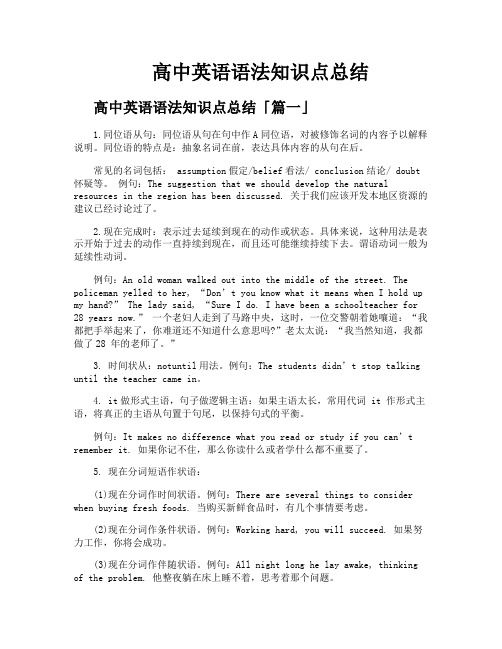
高中英语语法知识点总结高中英语语法知识点总结「篇一」1.同位语从句:同位语从句在句中作A同位语,对被修饰名词的内容予以解释说明。
同位语的特点是:抽象名词在前,表达具体内容的从句在后。
常见的名词包括: assumption假定/belief看法/ conclusion结论/ doubt 怀疑等。
例句:The suggestion that we should develop the natural resources in the region has been discussed. 关于我们应该开发本地区资源的建议已经讨论过了。
2.现在完成时:表示过去延续到现在的动作或状态。
具体来说,这种用法是表示开始于过去的动作一直持续到现在,而且还可能继续持续下去。
谓语动词一般为延续性动词。
例句:An old woman walked out into the middle of the street. The policeman yelled to her, “Don’t you know what it means when I hold up my hand?” The lady said, “Sure I do. I have been a schoolteacher for 28 years now.” 一个老妇人走到了马路中央,这时,一位交警朝着她嚷道:“我都把手举起来了,你难道还不知道什么意思吗?”老太太说:“我当然知道,我都做了28 年的老师了。
”3. 时间状从:notuntil用法。
例句:The students didn’t stop talking until the teacher came in。
4. it做形式主语,句子做逻辑主语:如果主语太长,常用代词 it 作形式主语,将真正的主语从句置于句尾,以保持句式的平衡。
例句:It makes no difference what you read or study if you can’t remember it. 如果你记不住,那么你读什么或者学什么都不重要了。
高三高考英语语法复习知识点总结五篇
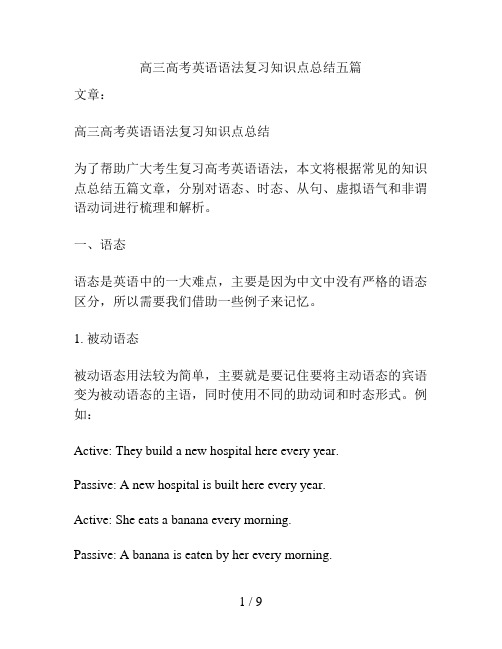
高三高考英语语法复习知识点总结五篇文章:高三高考英语语法复习知识点总结为了帮助广大考生复习高考英语语法,本文将根据常见的知识点总结五篇文章,分别对语态、时态、从句、虚拟语气和非谓语动词进行梳理和解析。
一、语态语态是英语中的一大难点,主要是因为中文中没有严格的语态区分,所以需要我们借助一些例子来记忆。
1. 被动语态被动语态用法较为简单,主要就是要记住要将主动语态的宾语变为被动语态的主语,同时使用不同的助动词和时态形式。
例如:Active: They build a new hospital here every year.Passive: A new hospital is built here every year.Active: She eats a banana every morning.Passive: A banana is eaten by her every morning.2. 主动语态主动语态用法就是正常的语态,也是比较简单的。
一般来说,我们常常使用主动语态,尤其是在描述我们自己或别人正在进行的动作。
Active: He writes a letter to his friend.Passive: A letter is written to his friend by him.Active: She plays the piano every afternoon.Passive: The piano is played every afternoon by her.3. 非定语动词非定语动词指的是在句子中作为谓语动词的动词,也就是我们最常见的动词形式。
在语态中,非定语动词主要是用来表示一些情感、感叹或存在状态等。
Active: She loves him deeply.Passive: He is loved deeply by her.Active: They usually send the report to the boss.Passive: The report is usually sent to the boss by them.二、时态时态也是英语语法中的一大难点,考生需要掌握现在时、过去时、将来时和完成时等几个常见时态。
高考英语语法体系
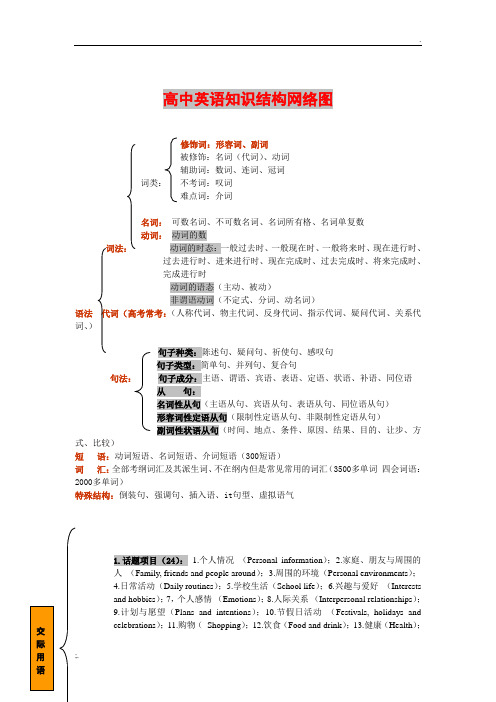
高中英语知识结构网络图修饰词:形容词、副词被修饰:名词(代词)、动词辅助词:数词、连词、冠词词类:不考词:叹词难点词:介词名词:可数名词、不可数名词、名词所有格、名词单复数动词:动词的数词法:动词的时态:一般过去时、一般现在时、一般将来时、现在进行时、过去进行时、进来进行时、现在完成时、过去完成时、将来完成时、完成进行时动词的语态(主动、被动)非谓语动词(不定式、分词、动名词)语法代词(高考常考:(人称代词、物主代词、反身代词、指示代词、疑问代词、关系代词、)句子种类:陈述句、疑问句、祈使句、感叹句句子类型:简单句、并列句、复合句句法:句子成分:主语、谓语、宾语、表语、定语、状语、补语、同位语从句:名词性从句(主语从句、宾语从句、表语从句、同位语从句)形容词性定语从句(限制性定语从句、非限制性定语从句)副词性状语从句(时间、地点、条件、原因、结果、目的、让步、方式、比较)短语:动词短语、名词短语、介词短语(300短语)词汇:全部考纲词汇及其派生词、不在纲内但是常见常用的词汇(3500多单词四会词语:2000多单词)特殊结构:倒装句、强调句、插入语、it句型、虚拟语气1.话题项目(24): 1.个人情况(Personal information);2.家庭、朋友与周围的人(Family, friends and people around);3.周围的环境(Personal environments);4.日常活动(Daily routines);5.学校生活(School life);6.兴趣与爱好(Interestsand hobbies);7,个人感情(Emotions);8.人际关系(Interpersonal relationships);9.计划与愿望(Plans and intentions);10.节假日活动(Festivals, holidays andcelebrations);11.购物(Shopping);12.饮食(Food and drink);13.健康(Health);14.天气(Weather);15.文娱与体育(Entertainment and sports);16.旅游和交通(Traveland transport);17.语言学习(Language learning);18.自然(Nature);19.世界和环境(The world and the environment);20.科普知识与现代技术(Popular scienceand modern technology);21.热点话题(Topical issues);22.历史和地理(Historyand geography);23.社会(Society);24.文学与艺术(Literature and art)2.功能意念项目(11):(特别注意1. 社会交往 (Social Communications)中的22项)(1)问候(Greetings)(2)介绍(Introduction)(3)告别(Farewells )(4)感谢(Thanks )(5)道歉(Apologies)(6)邀请(Invitation)(7)请求允许(Asking forpermission )(8)祝愿和祝贺(Expressing wishes and congratulations)(9)提供帮助(Offering help)(10)接受或拒绝(acceptance and refusal)(11)约会(Making appointments )(12)打电话(Making telephone calls )(13)就餐(Havingmeals)(14)就医(Seeing the doctor)(15)购物(Shopping)(16)问路(Askingthe way)(17)谈论天气(Talking about weather)(18)语言交际困难(Languagedifficulties in communication)(19)提醒注意(Reminding)(20)警告和禁止(Warning and prohibition)(21)劝告(Advice)(22)建议(Suggestions)听:语句理解、情景反应、对话理解、语篇理解说:正确区分交际场合,培养英语语感,了解英语交际功能读:基本技能(扫读、略读、准确获取信息、领会推断隐含含义)1.读懂语篇或段落主旨大意。
英语知识体系简介
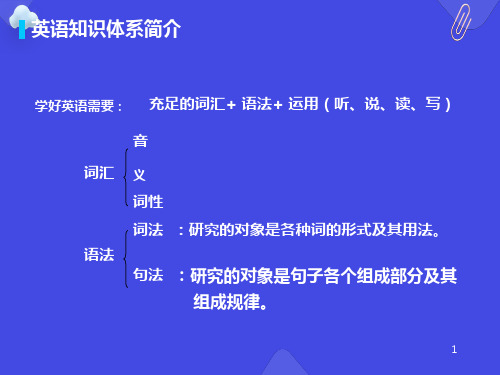
e.g. 1.The sun was shining. 2. The moon rose. 3. Who cares? 4. What he said does not matter. 5. They talked for half an hour. 6. The pen writes smoothly
form word 虚词
*
九种句子成分
02
主语(subject)
谓语(predicate)
表语(predicative)
宾语(object)
定语(attribute)
ቤተ መጻሕፍቲ ባይዱ
状语(adverbial)
08
同位语
主语补足语
*
九种句子成分
主语(subject):
谓语(predicate):
表语(predicative):
英语知识体系简介
充足的词汇+ 语法+ 运用(听、说、读、写)
词汇
音
义
词性
学好英语需要:
语法
词法
句法
:研究的对象是各种词的形式及其用法。
:研究的对象是句子各个组成部分及其 组成规律。
*
英语词类的变化形式有:
1 名词、代词的数、格、性的变化。 2 形容词、副词的比较级、最高级的变化。 3 动词的人称、时态、语态和语气的变化。
短语、句子、从句
短语:
具有一定意义的一组词, 可作为句子的一个成分。
英语中有下列几种短语:
1. 不定式短语
2. –ing 短语
3. 过去分 词短语
4. 介词短语
5. 名词短语
e.g. He likes to watch TV while having lunch.
高三英语语法知识点包括哪些

高三英语语法知识点包括哪些高三英语语法知识点一、一般过去将来时1.概念:立足于过去某一时刻,从过去看将来,常用于宾语从句中。
2.时间状语:Thenextday(morning,year…),thefollowingmonth(week…),etc.3.基本结构:主语+was/were+goingto+do+;主语+would/should+do+其它4.否定形式:主语+was/were+not+goingto+do;主语+would/should+not+do.5.一般疑问句:was或were放于句首;would/should提到句首。
6.例句:HesaidhewouldgotoBeijingthenextday.他说他第二天要去北京。
Iaskedwhowasgoingthere.我问,谁要去那里。
二、现在进行时1.概念:表示现阶段或说话时正在进行的动作及行为。
2.时间状语:Now,atthistime,days,etc.look.listen3.基本结构:主语+be+doing+其它4.否定形式:主语+be+not+doing+其它5.一般疑问句:把be动词放于句首。
6.例句:Howareyoufeelingtoday?你今天感觉如何?Heisdoingwellinhislessons.在课上他表现得很好。
怎样正确学习英语很多人都有看过美国电影,其实看电影学习英语也是不错的方式,可以保持对学习的新鲜感,搭配字幕观看,还有助于记忆单词,帮助纠正不良的口语习惯。
听英文歌也是很多人都喜欢做的事,它也可以帮助我们学习英语,可以学习歌词中单词的连接以及如何将语句写的通顺并且有美感,还可以锻炼英文写作能力。
也可以看原声新闻和听广播电,节目中主持人和播报原都经过专业训练,英语读音规范化,听的过程中可以学习语句的发音特点以及单词的使用,对于训练有很大的帮助。
英语的学习在日常生活中也会用到。
最开始说英语可能会说的不好但是要有信心,你只有将其表达出来,才会发现自己的不足并去弥补。
高三英语语法知识点有哪些

高三英语语法知识点有哪些随着高三英语考试的临近,语法知识点的复习变得尤为重要。
在这篇文章中,我们将介绍一些高三英语中常见的语法知识点,希望对同学们的备考有所帮助。
一、时态与语态时态和语态是英语语法中的基本知识点。
时态指的是动词在句子中表示的时间关系,如一般现在时、一般过去时、一般将来时等。
语态指的是动词的句子主语与动作之间的关系,如主动语态和被动语态。
同学们要熟练掌握各个时态和语态的用法,并在句子中正确运用。
二、名词与代词名词与代词是句子中的主要成分之一。
名词可以指具体的人、物或抽象的概念,而代词则可以替代名词在句子中的位置。
同学们需要了解名词的单复数形式、所有格以及代词的人称、数和格等不同的用法,并在写作中避免使用不恰当的名词或代词。
三、形容词与副词形容词与副词在句子中充当修饰词的角色。
形容词描述名词的性质或特征,而副词则描述动词、形容词或其他副词的性质或程度。
同学们应该掌握形容词与副词的比较级和最高级形式,并在句子中准确使用。
四、介词与连词介词和连词在句子中连接其他词语或短语,使句子结构更加完整。
介词通常在名词或代词前面,而连词则连接句子中的不同部分。
同学们需要了解介词和连词的常见用法,并准确运用于句子中。
五、动词的非谓语形式动词的非谓语形式包括动词不定式、动名词和分词。
它们可以作为主语、宾语或状语出现在句子中,并且不受时态和语态的限制。
同学们需要熟练掌握动词的非谓语形式的各种形式和用法,并在写作中恰当使用。
六、从句从句是句子中的一种独立成分,它包含一个主语和一个谓语,并能够在句子中做主句的一个成分。
从句分为名词性从句、定语从句和状语从句,同学们需要了解从句的引导词和从句中的时态和语态的用法,并在句子中正确使用。
七、倒装句倒装句是英语中一种常用的句子结构形式,一般将谓语动词放在主语之前,常见的有完全倒装和部分倒装。
同学们需要了解倒装句的常见用法,并在写作中适当运用。
八、虚拟语气虚拟语气是英语中用来表示虚假的、假设的或不可能实现的情况的一种语法形式。
- 1、下载文档前请自行甄别文档内容的完整性,平台不提供额外的编辑、内容补充、找答案等附加服务。
- 2、"仅部分预览"的文档,不可在线预览部分如存在完整性等问题,可反馈申请退款(可完整预览的文档不适用该条件!)。
- 3、如文档侵犯您的权益,请联系客服反馈,我们会尽快为您处理(人工客服工作时间:9:00-18:30)。
2009年语法知识--英语知识体系简介十大词类:noun, pronoun, adjective, adverb, numeral, verb, article, preposition, conjunction, Interjection九种句子成分主语(subject): 是句子所要说明的人或事物,是句子的主体。
(n., pron.,to do, doing and that-clause)谓语(predicate): 说明主语所发出的动作或从的状态。
(verbs)表语(predicative): 放在连系动词之后,表示主语的身分、状态或特征。
(n., pron., adj., adverbs for places, prepositional phrases, to do doing, done and that-clause.)宾语(object): 在及物动词或介词之后。
(n, pron, to do, doing and that-clause.)定语(attribute): 限定或修饰名词或代词。
adj., adverbs for places, pron, n., prepositional phrases, to do, doing, done and that-clauses.状语(adverbial) : 修饰动词、形容词、副词或整个句子。
adv., prepositional phrases, to do, doing done and that-clauses.宾语补足语(object complement): 说明宾语的性质、状态、特征或宾语发出的动作。
(adj., n, adverbs for places, to do, doing and done)同位语: 补充说明前面的某个名词或代词。
(n. or that-clauses)e.g. My father, a doctor, is very kind.主语补足语: 是对一句话的主语进行补充说明。
eg: 1.Jessica, the best student of our class, won the game.2.Tired and sleepy, I went to bed. 3. He died young.练习一:分析下列句子的成分1.The farmers don’t stay long in the same places.2.We are having a wonderful time.3.It’s dangerous to swim in the river.4.I watched all the glasses that were on the table fall off onto the floor.5.I’m going to move to another city next month.6.Thank you for writing to me.7.It was lovely to hear from you.8.Have you anything to say about this question?9.It’s getting dark.短语、句子、从句短语:具有一定意义的一组词,可作为句子的一个成分。
英语中有下列几种短语:1. 不定式短语e.g. He likes to watch TV while having lunch.2. –ing 短语e.g. I saw many people standing by the lake.3. 过去分词短语e.g. Given more time ,I would do it better.4. 介词短语e.g. With his help, I have finished writing the poem.5. 名词短语e.g. dark blue sky / a true story/ the most wonderful moment从句(clause): 含有主谓结构的一组词,在句子中作一个成分,一般由连接词、关系代词或关系副词引导。
e.g. If you want to say something, say it clearly.名词性从句:主语从句,宾语从句,表语从句,同位语从句形容词性从句:定语从句副词性从句:状语从句句子:sentence含有主谓结构的一组词,有比较完整的意义。
句子的类型从句子结构本身来看,句子可分为:简单句:只有一个主谓结构的句子。
e.g. This kind of computer could be made in China even in the seventies.并列句:由并列连词把两个或两个以上的简单句连在一起构成。
e.g. I asked Dick for some help, but he couldn’t do it , either.复合句:含有一个主句和一个或更多的从句。
e.g. They were deeply moved by what they saw and heard there.练习二:判断下面哪一个是句子1.The first thing we should do is to solve the problem at once.2.His returning to our country.s of villages and small towns.4.Take care of yourself when you are away from home.5.To discover the secret of the nature.6.In this restaurant the food is good , but the service is poor.7.The thought of her own plan8.Bought a ticket from the conductor.9.Inventions such as eyeglasses and the sewing machine have had an important effecton our lives?练习三:说出下列句子的类型1.Let him have a rest.2.The boy is clever yet he is not diligent.3.Either you are right or I am .4.My classmates and I study and play together.5.He once lived and worked there.6.No one can reply whether it will rain tomorrow.7.It seemed that they had lost something.8.The lessons he taught were important.9.Don’t miss the chance, or you will regret it.10.I began to go to school at the age of six.句子的种类从说话人的目的来看,句子可分为:陈述句:陈述一项事实。
疑问句:提出问题。
祈使句:表示请求、建议和命令。
感叹句:表示强烈的情感。
e.g. What a lovely day! How stupid you are!练习四:说出下列句子的种类1.Be quiet. Let’s begin our meeting.2.I enjoy the quietness of the country.3.What a wonderful birthday I am having!4.Do these chocolates belong to us?5.How disappointed Jenny was!6.Something must be done to stop pollution.7.Miss Lin went to Hong Kong for a holiday.8.Take an umbrella along; it’s likely to rain.9.Inventions such as eyeglasses and the sewing machine have had an important effect onour lives.英语中的六种基本句型词类和句子成分是不同的概念。
同一个词类可以在句中充当不同的成分,同一个句子成分也可以由不同的词类来担任。
基本句型一:主+系+表基本句型二:主+谓基本句型三:主+谓+宾基本句型四:主+谓+间宾+直宾基本句型五:主+谓+宾+宾补基本句型六:There be + 主语+ 状语英语基本句型-1 主系表句型此句型的句子有一个共同的特点:句子谓语动词都不能表达一个完整的意思,必须加上一个表明主语身份或状态的表语构成复合谓语,才能表达完整的意思。
这类动词叫做连系动词。
1. You are right.2. The playground is now in front of the school.3. It was 7:15 on the morning of February 8, 2000.4. Opinions are divided on the question.5. 60% of the students are against the idea of entrance fees.主系表结构:本结构是由主语+系动词+表语组成,主要用以说明主语的特征,类属,状态,身份等。
系动词有:1.表示特征和存在状态的be, seem, feel, appear, look, smell, taste, sound;2.表示状态延续的remain, stay, keep, continue, stand;3.表示状态变化的become, get, turn, go, run, fall, come, grow;Our English teacher is thirty years old.The cake tastes delicious.We feel used to living in big cities.The potatoes went bad in the fields.Their boss seems satisfied with the work.Deep water stays still.主系表句型的几个特例:1. As in China, the weather is different from area to area.2. We are greatly surprised to meet him there.3. It is not a good idea to spend your vacation with strangers.4. It is kind of you to say so.5. It is not easy for them to go there by bike.6. Is it Tom who is playing the piano?7. It is a fact that they can’t pass the exam.英语基本句型-2 主谓结构特点:句子的谓语动词都能表达完整的意思。
